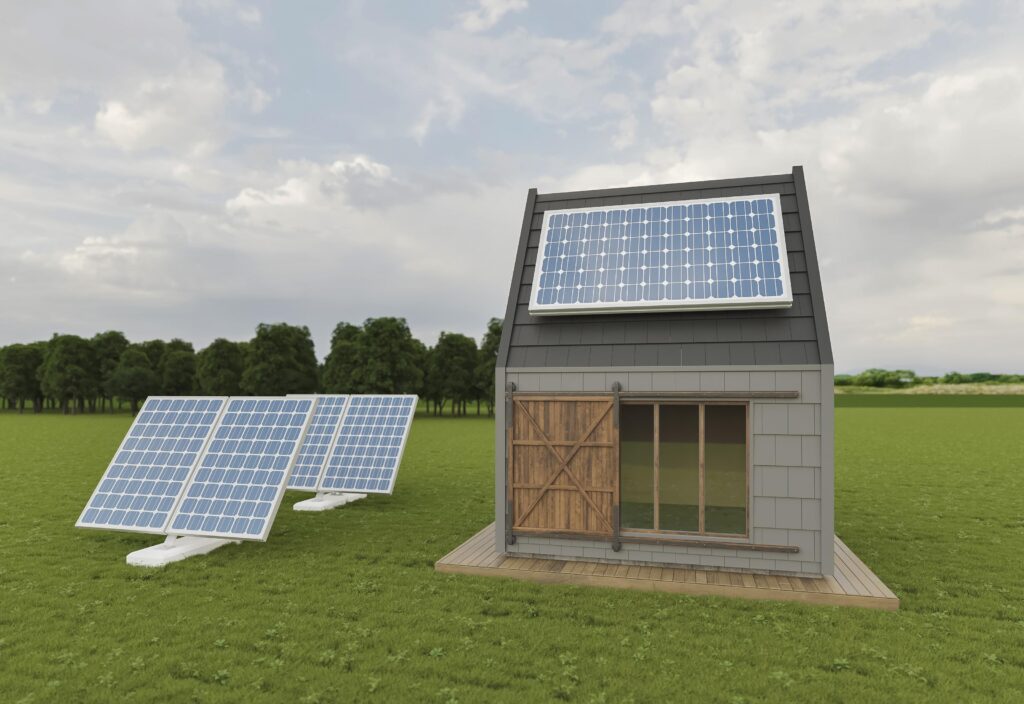Introduction to Solar Energy for Tiny Homes
In recent years, the trend of tiny living has gained significant momentum. More people are embracing minimalism, sustainability, and the freedom of downsizing. One of the most effective ways to enhance the sustainability of a tiny home is by integrating solar power. Solar power for tiny houses is not just a trend; it’s a practical solution that allows homeowners to harness renewable energy while enjoying the benefits of modern living.
Benefits of Solar Energy for Tiny Homes
Solar power for tiny houses offers numerous advantages. First and foremost, it promotes sustainability by harnessing renewable energy, which helps reduce your carbon footprint. Solar power systems can significantly lower your electricity bills, allowing tiny homeowners to save money over time. Additionally, using solar energy provides energy independence, especially for those living off the grid or in remote areas. This autonomy ensures that you have a reliable power source regardless of utility company fluctuations. Furthermore, investing in solar power can increase the overall value of your tiny house, making it more appealing to potential buyers who prioritize eco-friendly living. Overall, solar power is a practical and beneficial choice for tiny house enthusiasts.
Solar Energy Solutions for Tiny Homes

Why Choose Solar Panels for a Tiny House?
Choosing solar power for tiny houses is an excellent option for several compelling reasons. First, it promotes sustainability by harnessing renewable energy, which helps reduce your carbon footprint. Solar power systems can significantly lower your electricity bills, allowing tiny homeowners to save money over time. Additionally, using solar energy provides energy independence, especially for those living off the grid or in remote areas. This autonomy ensures that you have a reliable power source regardless of utility company fluctuations. Furthermore, investing in solar power can increase the overall value of your tiny house, making it more appealing to potential buyers who prioritize eco-friendly living. Overall, solar power is a practical and beneficial choice for tiny house enthusiasts.
Types of Solar Panels for Tiny Homes
When selecting solar panels for tiny houses, it’s essential to understand the different types available. Monocrystalline panels are highly efficient and space-saving, while polycrystalline panels are generally less expensive. Thin-film panels are lightweight and flexible, making them suitable for various installations.
When considering energy solutions for a tiny home, solar panels stand out as an optimal choice for several reasons:
1. Cost-Effective Energy Solution
One of the primary advantages of installing solar panels for a tiny house is the potential for significant cost savings. Traditional energy sources can be expensive, especially in remote areas where utility companies may charge higher rates. By investing in solar energy, tiny homeowners can reduce or even eliminate their electricity bills.
2. Sustainable and Eco-Friendly
Solar energy is a clean, renewable resource. Unlike fossil fuels, which emit harmful greenhouse gases, solar power generates electricity without polluting the environment. By choosing solar panels, tiny homeowners can contribute to a healthier planet and promote sustainable living practices.
3. Energy Independence
For those living in remote locations or off-grid, solar power provides a reliable energy source. An off-grid cabin solar system allows homeowners to generate their own electricity, reducing reliance on utility companies and enhancing self-sufficiency. This independence is particularly appealing for those seeking a simpler, more connected lifestyle with nature.
4. Increased Property Value
Investing in solar panels can also increase the value of your tiny home. As more buyers look for energy-efficient and sustainable living options, having a solar power system can make your property more attractive in the real estate market.
How Solar Panels Work
Solar panels consist of photovoltaic (PV) cells that convert sunlight into electricity. When sunlight hits the PV cells, it excites electrons, generating direct current (DC) electricity. This electricity is then sent to an inverter, which converts it into alternating current (AC) electricity for household use.
Components of a Tiny Home Solar System
Creating an efficient tiny home solar system requires understanding the various components involved. Each part plays a crucial role in ensuring that your solar energy system operates effectively.
Solar Panels
Solar panels are the primary component of any solar power system. They capture sunlight and convert it into electricity, powering your tiny home efficiently.
Inverter
An inverter is necessary to convert the direct current (DC) produced by solar panels into alternating current (AC), which is used in most household appliances.
Battery Storage
For those who want to live off the grid, battery storage is essential. It allows you to store excess energy generated during sunny days for use at night or during cloudy weather.
Charge Controller
A charge controller regulates the voltage and current coming from the solar panels to the batteries, preventing overcharging and ensuring longevity.
Off-Grid Cabin Solar System: A Practical Solution
If you’re considering an off-grid cabin solar system, it’s vital to assess your energy needs. Calculate the total wattage of your appliances to determine the size of the solar system you require.
Assessing Your Energy Needs
- Calculate Total Wattage: Start by listing all the appliances and devices you plan to use in your tiny home. Calculate the total wattage required to run them.
- Consider Usage Patterns: Think about when you will use these appliances. For example, if you primarily use your refrigerator and lights at night, you’ll need a system that can store enough energy for those times.
- Account for Seasonal Variations: Depending on your location, energy production can vary throughout the year. Make sure to account for seasonal changes in sunlight availability.
Designing Your Solar System
Once you have a clear understanding of your energy needs, you can design your solar system:
- Choose the Right Size: Based on your wattage calculations, determine how many solar panels you will need.
- Select Battery Capacity: Choose batteries that can store enough energy to meet your needs during low sunlight periods.
- Plan for Future Expansion: Consider whether you might want to add more appliances or devices in the future. Designing your system with expansion in mind can save you time and money later on.
Tips for Installing Solar Panels on Tiny Homes
Installing solar panels on a tiny home can seem daunting, but with the right preparation and knowledge, it can be a straightforward process. Here are some essential tips:
1. Assess Your Roof Space
Before purchasing solar panels, evaluate your roof space. Ensure you have enough area to accommodate the number of panels needed for your energy requirements. Additionally, consider the angle and orientation of your roof, as these factors can impact the efficiency of your solar panels.
2. Choose the Right Orientation
Positioning your solar panels to maximize sunlight exposure is crucial. Ideally, panels should face south (in the Northern Hemisphere) or north (in the Southern Hemisphere) to capture the most sunlight throughout the day. If your roof has shading from trees or buildings, consider alternative mounting options, such as ground-mounted systems.
3. Consider Local Regulations
Before installation, check local zoning laws and building codes. Some areas may have restrictions on solar panel installations or require permits. Understanding these regulations beforehand can save you time and potential legal issues.
4. Hire a Professional or DIY
Decide whether you want to hire a professional installer or tackle the project yourself. While hiring a professional can ensure a proper installation, DIY projects can be rewarding and cost-effective if you have the necessary skills.
5. Regular Maintenance
Once your solar panels are installed, regular maintenance is essential to ensure optimal performance. Clean the panels periodically to remove dirt and debris, and inspect the system for any signs of damage or wear.
Solar power for tiny houses
Investing in a tiny home solar kit can simplify the process of going solar. These kits typically include all the necessary components for a solar power system, making installation more accessible for homeowners. Here are some benefits of using a solar kit:
1. Comprehensive Solutions
Tiny home solar kits come with everything you need, including solar panels, inverters, charge controllers, and mounting hardware. This comprehensive approach simplifies the buying process and ensures compatibility between components.
2. Cost-Effective
Purchasing a solar kit can be more cost-effective than buying components separately. Many manufacturers offer bundled discounts, making it easier to stick to your budget.
3. User-Friendly Installation
Most solar kits are designed for easy installation, with clear instructions and support available. This user-friendly approach allows even those with limited experience to set up their solar system successfully.
4. Scalable Options
Many solar kits are scalable, meaning you can start with a smaller system and expand it as your energy needs grow. This flexibility is particularly beneficial for tiny homeowners who may want to add more appliances or devices over time.
Real-Life Examples of Solar Power in Tiny Homes
To illustrate the effectiveness of solar power for tiny houses, let’s explore some real-life examples:
Example 1: The Off-Grid Tiny Cabin
A couple living in a remote area decided to build a tiny cabin powered entirely by solar energy. They installed a 1.5 kW solar panel system, complete with battery storage. This setup allows them to power their refrigerator, lights, and small appliances while enjoying the tranquility of off-grid living. They report significant savings on energy costs and appreciate the independence that solar power provides.
Example 2: The Mobile Tiny Home
A family living in a mobile tiny home opted for a portable solar kit. This system includes foldable solar panels that they can set up wherever they park. With this flexible solution, they can enjoy the benefits of solar power while traveling. The family appreciates the convenience and sustainability of their mobile solar system, which allows them to minimize their environmental impact.
Example 3: The Urban Tiny House
In an urban setting, a tiny homeowner installed a rooftop solar system to power their compact dwelling. With limited roof space, they chose high-efficiency monocrystalline panels, which provide maximum energy output. The homeowner has successfully reduced their electricity bills and enjoys the satisfaction of living sustainably in the city.
Conclusion
Solar power is a transformative solution for tiny houses, offering a sustainable and cost-effective energy source. By investing in the right tiny home solar kit, homeowners can enjoy energy independence, reduce their carbon footprint, and contribute to a healthier planet. Whether you’re living off-grid or in an urban setting, solar power can enhance your tiny living experience.As you embark on your journey to harness solar energy, remember to assess your energy needs, choose the right components, and consider professional installation if necessary. With careful planning and the right resources, you can successfully integrate solar power into your tiny home, enjoying the benefits of renewable energy for years to come.
Solar power is a game-changer for tiny houses. By choosing the right tiny home solar kit, you can enjoy energy independence while contributing to a healthier planet.






